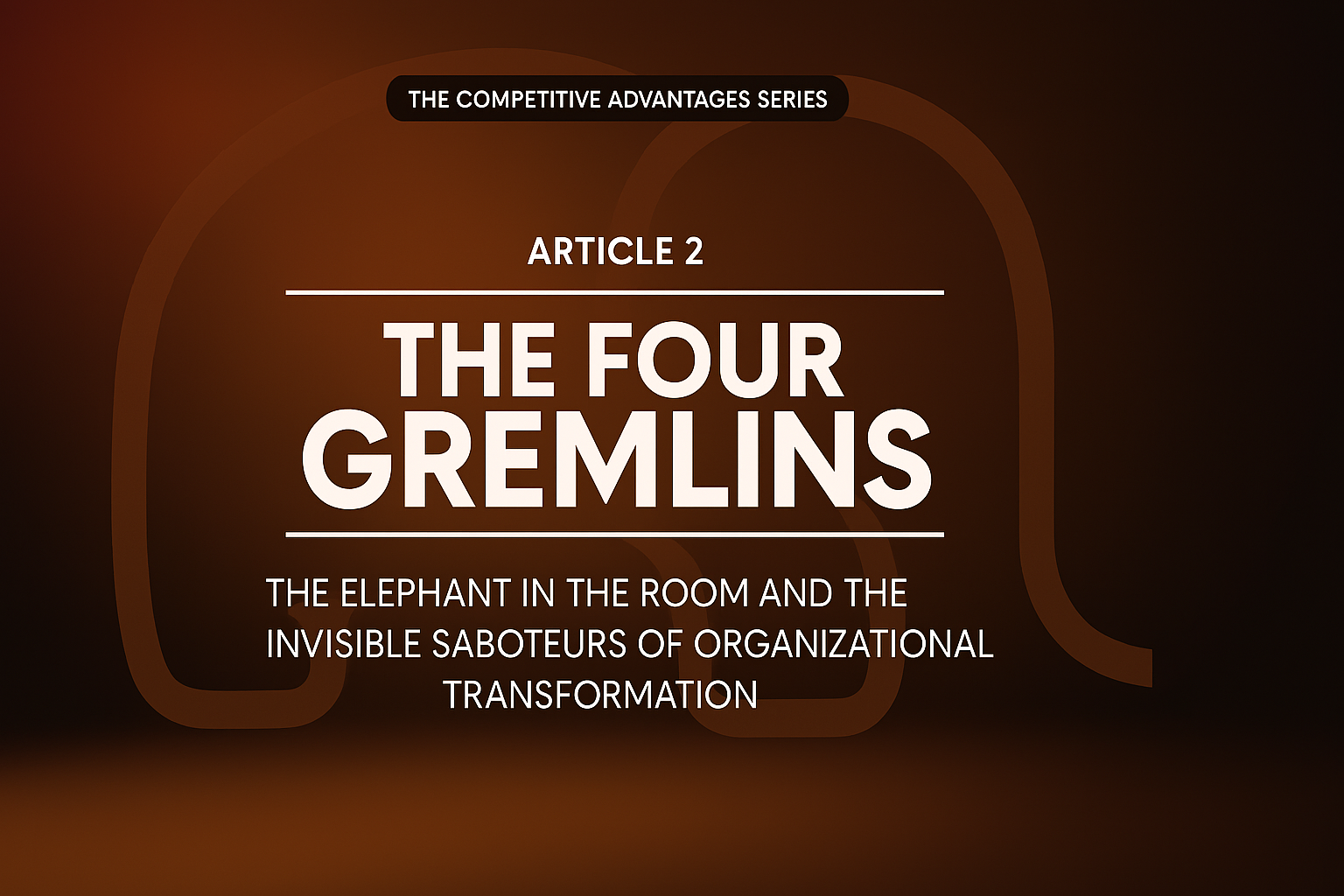By: Rosa Zapata, Director of CDI Latin America and Partner with Competitive Dynamics International
For citation please use: Zapata, R. (2024). The four gremlins. In McNeil, J. & McNeil D. The five keys to continuous improvement (pp. 255-262).
The Elephant in the Room
Have you ever wondered how many times the skepticism of a few has slowed down the progress of an entire organization?
In any business cultural transformation, there are inevitable challenges that must be identified and addressed from the beginning. Those willing to embark on this journey need to not only recognize these challenges, but also have an effective plan in place to mitigate them in time. Otherwise, progress may be compromised.
As promoters of change, our role is to advise, coach, advise and share our experience with organisational leadership. This accompaniment is an opportunity both to guide and to learn from those who make the final decisions. It’s an iterative process, in which both sides grow and adapt. Many of the key decisions are directly related to the challenges that arise throughout the transformation process and the way they are addressed.
Over the years, I have observed that certain challenges are recurring, regardless of the sector or industry. These appear at different stages of the continuous improvement process and affect both strategic and operational teams. Their goal: to slow progress, and they are almost always rooted in individual behaviors or organizational dynamics.
I call these challenges The Four Gremlins, and it is essential to keep them under control
According to the Oxford dictionary, a gremlin is a mischievous creature from folklore, considered responsible for unexplained failures in machines or aircraft.
Gremlin 1: Silo
The “silo” refers to an organization where information and knowledge are not shared, causing isolation between areas and teams. This gremlin appears especially when each member interprets the team’s goals differently. The causes can range from a lack of discussion and clarity of purpose to poor leadership team cohesion. The effect is organizational misalignment, reactive management in the face of crises, absence of clear goals and, therefore, dissatisfied collaborators and customers. Therefore, it is essential to quickly identify and attack the conditions that reinforce this paradigm.
As obvious as the silo problem may seem, it remains a recurring obstacle, even in well-intentioned teams looking to instill a world-class mentality. Tools to assess the clarity of objectives and the perception of a common goal are essential to overcome it. Organizational clarity always starts with the management team.
Gremlin 2: Inertia
In physics, inertia is the tendency to remain in the same state, barring the intervention of an external force. In companies, it translates into inaction: when people do not fulfill their commitments to the team. Or, they undertake actions not aligned with the agreements. Having a common goal does not guarantee that progress will be uniform.
Inertia thrives when there is no sense of urgency, as John Kotter explains. It is usually enhanced when daily tasks overshadow long-term priorities, or when there are unclear roles or responsibilities. Unagreed actions can also be the result of ingrained habits, lack of understanding, lack of confidence to question, or passive resistance. Overcoming inertia requires genuine, active and visible leadership, willing to promote teamwork, accountability and the increase of standards. Healthy leadership is key to strategy: teamwork is a competitive advantage.
Gremlin 3: Disconnection
When launching a new initiative, it is vital to consider the transformation as a whole and not fragment efforts. This gremlin arises when the alignment between the different components of the transformation is lost. For example, when implementing software, it is essential to adapt solutions to both technical needs and human change management.
Active and visible leadership is fundamental in both dimensions: technical and human. It involves providing resources, promoting accountability, and celebrating progress, as well as facing uncomfortable conversations that are necessary to generate a sense of urgency and build trust. Recognizing and making success stories visible consolidates the new culture and motivates teams.
Gremlin 4: Skepticism
“Give me a lever long enough and a fulcrum on which to place it, and I will move the world.” – Archimedes.
A continuous improvement methodology can only be sustained if it is supported by a critical mass: people who understand, support and promote the new way of doing things. Skepticism arises when successful behaviors and beliefs in the past make it difficult to open up change. Changemakers must act as a “lever” that mobilizes the organization, helping to build that critical mass.
Keeping Silo, Inertia, and Disconnection gremlins in check depends, in large part, on getting enough people to embrace the transformation. Organizational excellence requires the active participation of everyone.
Ideas for reflection
- Clarity in the organization begins with clarity in the management team.
- A successful continuous improvement initiative is based on three basic elements: Active and visible leadership, a change management process, and a project management approach.
- Inaction and the performance of non-agreed actions are forms of inertia in the organization.
- A key objective of the change management process is to achieve critical mass.
We love to hear your voice, share your experience:
- To what extent does your organization have a critical mass ready to drive transformation, or is skepticism rife?
- Would you dare to identify which of the four Gremlins is the most lethal in the day-to-day running of your company?
- What would you do differently if you could anticipate the greatest risks during an organizational transformation?




Leave a reply